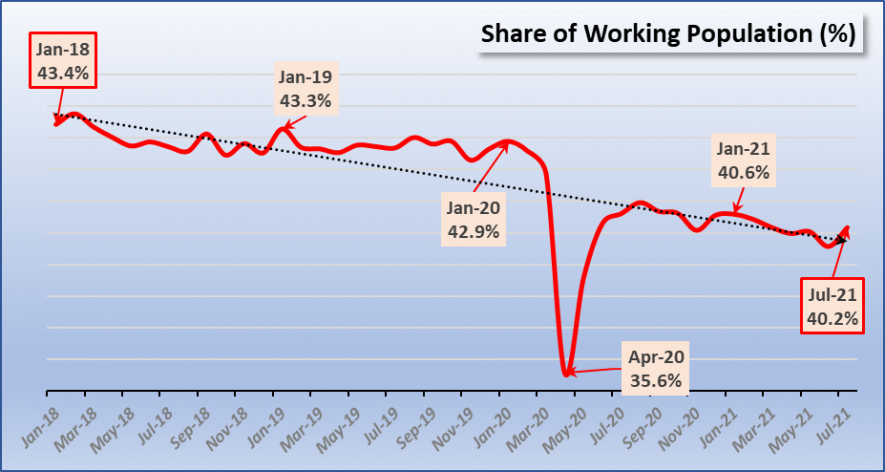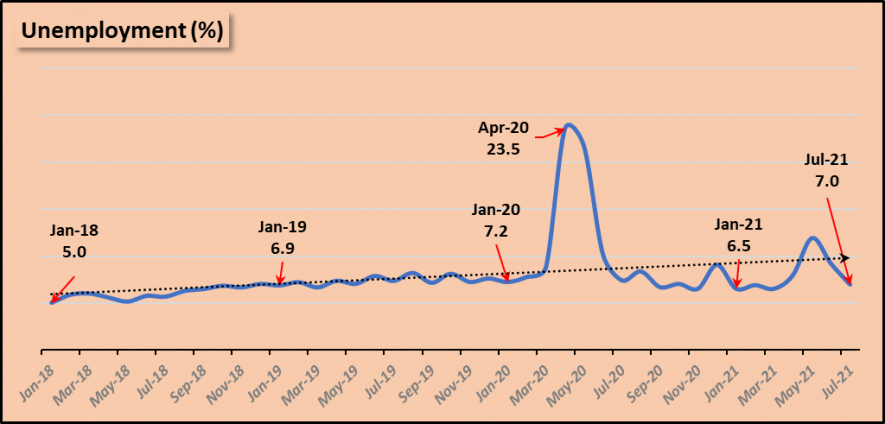Less Jobs, Even Lesser Income Crushing People’s Lives

People in India are in the grip of a severe income crisis brought on by myopic government policies and aggravated by mismanagement of the pandemic. Part of this economic collapse is because the absolute number of jobs has shrunk.
Another part – not much talked about – is because of low incomes from existing jobs. This explains the fact that while jobs periodically appear to bounce back and unemployment goes up and down, the economy continues to suffer, since incomes are insufficient. Those who lost their source of earnings in the past two rounds of lockdowns have not yet reached the income levels they had two years ago. Inflation, however, continues to further erode their meagre earnings.
Jobs Despair
First let us take a look at the jobs situation. Compared with January 2020 (before the pandemic), the share of the working population has gone down from about 42.9% to 40.2% in July 2021, as shown in the chart below based on CMIE (Centre for Monitoring Indian Economy) data. That is a decline of 2.7 percentage points, which would translate to about 1.3 crore. This is the loss in the pandemic period.
But if you compare with, say, January 2018, well before the pandemic, the decline is 3.2 percentage points. That’s about 1.5 crore less persons who are working or willing to work. This is a bizarre situation: even though the population is rising, and India is (or was) one of the ‘fastest growing’ economies in the world, there are now less number of people who are working!

Besides being a vivid indictment of the sorry state of affairs, there is another important point in this chart above: the decline had started before the pandemic. Between January 2019 and January 2020, labour force participation had already started declining. The economy was sinking even before the coronavirus appeared. All the pandemic did was to blow the bottom out of the leaking ship.
Labour force participation rates, like the ones shown above include both, those who are working and those who are unemployed but seeking work. In other words, it is the sum of employed and unemployed.
Now let us turn to the unemployment situation.
As shown in the chart below, there is a slow but relentless increase in unemployment. In January 2018, the unemployment rate was about 5%. This had increased to 7.2% in January 2020, just before the pandemic hit India.
During the first lockdown (April-May 2020), unemployment shot up to never-seen-before heights before sinking back to usual levels as the lockdown was eased. Yet, in July 2021 it was reported by CMIE to be around 7%, after increasing to over 11% in the lean summer months.

The unemployment rates of 6-8% under conditions of falling labour participation rates are unconscionable. This means that a large number of people have become so frustrated and despondent that they have given up looking for jobs and are sitting idle. These are not counted as ‘unemployed’ during surveys of the kind that CMIE does.
In other words, the unemployment situation is far more serious than what the unemployment rate shows.
Returning to Lower Income
Various estimates have been made about aggregate income losses in India due to the pandemic and lockdowns. Last year, economist Jayan Jay Thomas had estimated that India’s workforce lost about Rs. 4.12 lakh crore worth of income due to the first lockdown. That is about 2.2% of India’s GDP (gross domestic product). He pointed out that the bulk of these losses were suffered by lower income workers, such as casual workers or self-employed. A study by a financial firm earlier this year estimated that the aggregate income losses in one year of the pandemic amounted to a mind boggling Rs.13 Lakh crore.
This massive loss of incomes has devastated household budgets across various economic strata in the country, sparing only the rich who have enough to tide over these blips. Reserve Bank of India data has shown that institutional savings have declined and debt has grown as households scramble to raise resources to meet their daily needs. Other surveys have shown that food intake has gone down since the government provided only a limited amount of free grain to ration card holders, leaving out an estimated 10 crore people at the least.
The country’s working population is thus carrying an unbearable load on its shoulders. It is in these conditions that the so-called ‘bounce back’ of jobs turns out to be deceptive, because incomes are still not bouncing back.
According to the most recent data available from the households survey done by CMIE, a massive 1.6 crore jobs were added in July 2021 compared with January-April 2021. This is an aggregated figure covering several sectors, some of which saw increases and some saw declines.
The category of small traders and daily wage labourers, perhaps some of the lowest earning sections, saw an increase of 1.86 crore in its ranks. This includes 1.12 crore people who found employment in agriculture, either as farmers or (mostly) as agricultural labourers.
This agriculture-related jobs spike is linked to kharif sowing, which was slightly delayed because of an errant monsoon. Data from previous years shows there is usually a spike in July followed by an exodus a couple of months later. So, these jobs are mere temporary relief, not some systemic improvement in the economy.
On the other side, salaried jobs fell by 32 lakh. These are relatively better paying jobs. Another low paying sector, construction, witnessed an increase of 54 lakh persons employed in it. Conversely, manufacturing showed a continuing fall of about eight lakh workers.
What this shows is that better paying and more secure jobs are disappearing, forcing people to go for transient earning opportunities, such as casual labour, in farms or elsewhere, or as petty shop keepers, vendors, hawkers etc.
Remember, that before the pandemic, salaried jobs (as estimated by CMIE) were pegged at 8.7 crore. Compared with that, the current level of 7.65 crore shows a steep fall of over one crore such jobs.
This is the nature of disguised or hidden unemployment – which is in addition to open and recorded unemployment. People are desperate, and just to survive, are working anywhere and at whatever wage or earning they can eke out of it. It is ephemeral and, in effect, forcing people into the jaws of poverty.
Get the latest reports & analysis with people's perspective on Protests, movements & deep analytical videos, discussions of the current affairs in your Telegram app. Subscribe to NewsClick's Telegram channel & get Real-Time updates on stories, as they get published on our website.
























